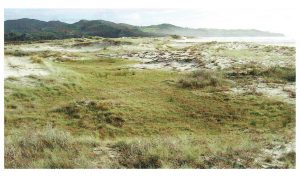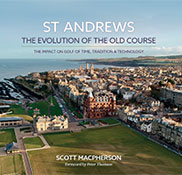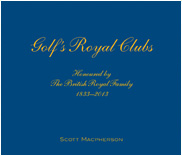GOLF CHAMPIONSHIPS ON SMGD COURSES:
At Close House – Colt Course. Sept 2017. A prestigious European Tour Championship hosted by Lee Westwood.
Broadcast worldwide from Royal Wellington Golf Club, NZ. October 2017. WOW!
The legacy continues.
Co-hosted at the award-winning Millbrook Resort near Queenstown, NZ. 2014 – 2023.
The Origins of Golf
‘Let us but ask ourselves why golf originated on links land and immediately it becomes clear. Here was terrain to be battled with- terrain which called forth skill, adroitness, finesse, power, daring and other fine qualities possesses by the athlete and the sportsman. Here were the great dunes to be carried, problems to be met and solved, masterly strokes to be made, dangers to be faced, Scylla here and Charybdis there, a path strewn with pitfalls on this side, a route secure but long on the other. These were the attractions which first drew men to the links and which have held them there ever since.’
Robert Hunter 1926.
Historians tell us that golf began on the sandy wastelands along the Scottish Coasts. When this information is conveyed to us, it often comes with photos of the Old Course in St Andrews on the east coast or Prestwick on the west. But in these photos the turf on the fairways is always short and manicured, greens are pure and smooth and bunkers are defined. While golf may have been played for hundreds of years at these long established locations and others, how the first courses may have appeared to the early pilgrims is now hidden from us. It intrigues me to visualise from where the first fairways and greens may have come, how the first courses looked and how the modern course has developed since.
It takes a sojourn into the sandy dunes along an undeveloped coastline to find the origins of the first courses. In these natural, windswept places where the hand of man has had little time to toil, one can find, if fortunate, islands of finer turf growing in the basins between the sandy ridges. Kept there by the sandy walls around them, these grasses have evolved from salt tolerant tussock grasses into quite distinctive habitats of fine leafed grasses- many with their own mirco-climates.
Of course, nothing happens quickly. It has taken a long period of time and many seasons for the soils in these low areas to naturally modify. The first stages would have almost certainly have been the initial establishment of the hardy dune-grasses. From here, due to the growth and decomposition of that flora, the nutrient content and structure of the sand would have improved and the pure sand ‘soil’ slowly developed into a sandy loam. Soon some wind-distributed seeds of the finer grasses such as Bent grass (Agrostis) and fescue (Festuca) would find their way to this receptive seedbed. At the right temperature these seeds would germinate and take hold, and after a few seasons their organic matter mixes with the sand further slowing the speed that rain water percolates though the sandy soil profile. With water now available, the new finer turf species grow stronger and soon spread eventually filling the entire dune basin forming perfect early green or fairway.
 |
I took this photo on a remote beach on Great Barrier Island in New Zealand. I believe this is how the links at St Andrews may have looked when golf (or ‘Goff’) was first played there 600 years ago. Indeed it still may have had an appearance more closely resembling this than the current look up until as recently as 1850. Golfers played from one area of fine turf to the next- island hopping over large areas of sandy dune. Of course there would be a hole dug here or there, but there was always a great degree of elasticity as to where it might be located. It’s location depending upon where the next suitable patch of grass lay.
Given that these fine-turf islands were treasured golfing pastures, it is somewhat surprising to learn that the first golfers- beyond the damage caused during normal play-deliberately caused further damage to these limited areas of play. Most notably history tells us that once a player had holed out, they first teed up the ball within one club length of the hole. Sand was used to tee the ball up. Before the advent of sand boxes that provided sand for this purpose, sand was gathered from the nearest source- this was often of the bottom of the previous hole. Neither the process of teeing off close to the previous hole nor digging sand from the hole helped improve the growth or maintain the condition of these finer areas of grass.
The playing of golf from tee to green did little to help stabilize the dunes either. While the existing areas of fine turf were being hacked up, any grasses trying to take hold elsewhere were in great danger of being downtrodden, buried or hacked to death in the general playing of the game. As a result, exposed dunes generally would stay exposed. This could mean that after large storms some sand may have blown across the desirable playing areas, but that was all part of the game.
Of course things had to change at some point to get us to where we are today. In the middle of the 19th century, from 1850-1880, it was the rapid expansion of the railway line that brought the first round of significant change. The railway allowed many more people to get to the golf links. Combined with the new, cheaper, gutta-percha ball golf dramatically increased in popularity. But hundreds of more feet and the thumping of irons into the sandy ground were a great threat to these reasonably delicate environments. Rule changes were required. In 1875 the rules provided for the first use of separate teeing grounds. This helped save the turf around the hole, and allowed the course to use areas of the dunes that may have been out of range previously.
Next came the souls who took upon the role of caring for the Links. Prior to the first dedicated ‘Keepers of the Green’, the cutting of the holes was looked after by the staff of the club under the heading of ‘general duties’. In 1774 at the Edinburgh Burgess’ Society this included “calling the members to dinner and changing the holes”, in that order. The first record of the term ‘Greenkeeper’ is in 1888 when Willie Fernie was appointed at Troon (now Royal Troon) as ‘greenkeeper, clubmaster and professional”. Prior to this however there were ‘Keepers of the Green’. Perhaps the most famous of these was Thomas Morris of St Andrews. During his tenure at St Andrews from 1865 to 1903 he revolutionised the role. Greens were top-dressed and he invented the first ‘hole cup’ to stop the newly cut holes from filling in with sand.
A look at the first golfing areas also reminds of the enormous change in bunker formations. Sand and grass have inversed their relationships in the modern game to what they had initially. Originally there were islands of grass amidst oceans of sand. Now it is the bunkers that are pinholes holes in the fabric of turf that covers the modern day course. Neither is necessarily better, but it does highlight the change, the difficulty of golf in the early days and how hazards are an indispensable part of golf challenge.
Early golf was an extreme adventure. If a shot missed the grassy island refuge amidst the large swaths of sand, the gorse and the tussock grasses, players forged their own way forward. Scores over 100 were the norm and perfect lies were once in a lifetime affairs. For the lucky few who visit courses such as Pine Valley, this situation still exists, but elsewhere things have changed. I am not advocating a return to difficulty of un-mown fairways, and the opening up of dunes alongside holes but it does make me wonder if all the ‘improvements’ made to golf have been for the better? With rising costs, slower rounds, and increasingly complex rules, has losing the sand cost us some of the spirit of golf also? Maybe not, but to find a better way forward, sometimes it’s best to look back first.
AWARDS
 Winner
Winner
Excellence in Compliance Award
Royal Wellington Golf Club
 Scott awarded by GEO as a Sustainable Golf Champion
Scott awarded by GEO as a Sustainable Golf Champion
PUBLICATIONS
 St Andrews
St Andrews
The Evolution of the Old Course
by Scott Macpherson
TESTIMONIALS
"Scott is a very good course designer and it's interesting to go around a course and see what he sees. I have my own ideas about courses and the way they should look, but listening to somebody like Scott, who has a lot of experience, makes you appreciate how much more there is to take into account when you are designing one."
Lee Westwood, CH Magazine, 2014.



